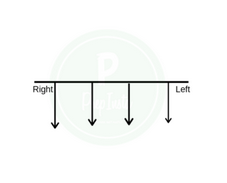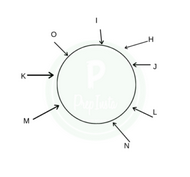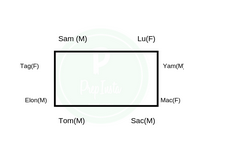Logical Menu
- Number Series
- Coding and Number Series
- Letter and Symbol Series
- Logical Sequence of Words
- Analogy and Classification Pattern
- Statements and Conclusions
- Statements and Assumptions
- Data Sufficiency
- Visual Reasoning
- Cube and Cuboid
- Cube
- Dice
- Directional Senses
- Blood Relations
- Odd Man Out
- Syllogism
- Arrangements
- Seating Arrangements
- Coding Deductive Logic
- Objective Reasoning
- Selection Decision Tables
- Attention to Details
- Inferred Meaning
- Cryprtarithmetic
- Get Off-campus Drive Updates
- Get Hiring Updates
- Contact US
PREPINSTA PRIME
Tips And Tricks And Shortcuts For Arrangement
Arrangement Tips and Tricks and Shortcuts:-
Arrangement problems can be asked in a variety of forms. So they have been divided into three different categories which are mentioned below namely:
The problems on seating arrangement are regular feature of almost every competitive examination. In these type of problems, you have to arrange a group of persons fulfilling certain conditions. This is also written as sitting arrangement or sitting arrangement reasoning at some places. Here we can classify these problems into 4 types:
- Linear Arrangement
- Circular arrangement
- Rectangular arrangement

Types of Arrangement
Here we can classify these problems into 4 types:
1. Linear Arrangement: Here the arrangement of the persons is linear i.e. you have to arrange them in a line. Here generally a single row of arrangement is formed. Double row arrangement: In these problems, there will be two groups of persons. You have to arrange one group in one row and the other group in other row. The persons in these rows normally face each other.
2. Circular arrangement: In the circular seating arrangement problems, you have to arrange the persons around a circular table etc. fulfilling certain conditions.
3. Rectangular arrangement: These arrangements are almost similar to the circular arrangements; the only difference is that the persons are sitting around a rectangular table.
Tips for Swiftly Solving Arrangement Questions
Arrangement questions can seem daunting, but with the right approach, you can tackle them swiftly and accurately. Whether you’re facing placement puzzles or sequence challenges, these tips will guide you to solve arrangement questions quickly and with confidence:
Scan and Identify: Begin by quickly scanning the question and identifying the given elements and conditions. Highlight or jot down key information to ensure you have a clear understanding of the problem.
Visualize the Setup: Visualize the arrangement in your mind or sketch a rough diagram. This mental map helps you grasp the relationships between elements and visualize potential solutions.
Start with Fixed Elements: If certain elements have fixed positions based on the conditions, start by placing them in their designated spots. This provides a foundation to build upon.
Apply Elimination: In multiple-choice scenarios, use the process of elimination. Analyze each option against the given conditions and eliminate those that don’t fit, narrowing down your choices.
Work Backwards: Sometimes, working backward from the given information can be effective. Begin with the last step or position and deduce the arrangement step by step.
Look for Clues and Inferences: Pay attention to clues hidden in the question. One condition might indirectly reveal the position of another element, allowing you to make quick inferences.
Utilize Constraints: As you place elements, keep track of constraints and conditions. Utilize this information to eliminate impossible placements and refine your arrangement.
Grouping Strategies: If the arrangement involves grouping, focus on constraints related to groups. Use this information to form clusters and deduce positions within those clusters.
Avoid Overcomplication: Keep your approach simple and logical. Overthinking or making assumptions not supported by the conditions can lead to errors and slow you down.
Practice Regularly: Like any skill, practice is essential. Engage in timed practice sessions to improve your speed and decision-making under pressure.
Stay Calm and Confident: Arrangement questions may appear complex, but stay calm and approach them confidently. Trust your analytical skills and apply the techniques you’ve practiced.
Review and Learn: After solving a question, review your solution to ensure it meets all conditions. If you encounter challenges, analyze your approach to identify areas for improvement.
Prime Course Trailer
Related Banners
Get PrepInsta Prime & get Access to all 200+ courses offered by PrepInsta in One Subscription
Also Check Out
Linear Arrangement Problems
They can be in the type of single row arrangement or double row arrangement or direction based problems (North, South, West, and East). It is illustrated with the help of an example below:
Single row arrangement
Under this type, we are asked to arrange a group of people in a single line or a row.
Question 1.
Monika is sitting beside Rachel.
Mike is sitting beside Ross, But Ross is not sitting next to Phoebe, who is seated at the extreme corner which is the left-hand side of the bench.
Mike is sitting in the second position from the right of the bench.
Monika is towards the right-hand side of Rachel and Phoebe.
Monika and Mike are sitting together.
Ques. i) In which position is Monika sitting
Options:
A. Between Rachel and Ross
B. Between Rachel and Mike
C. Between Phoebe and Ross
D. Between Mike and Phoebe
Correct Option: B
Explanation:

Phoebe Rachel Monika Mike Ross
As per the above diagram, Monika is sitting in the middle of the bench, between Mike and Rachel.
Therefore option B is the correct one.
Similarly, we shall be asked to arrange a group of people either in a double row or on the basis of directions.
Quick Tip for solving the double row or direction based question

While extracting the information and making the arrangement, we shall always focus on the direction towards which the person is facing.
If it is a double row arrangement, then both groups will be facing each other. One group will be facing towards the north, and the other one towards the south, and accordingly the directions will be considered as per the above diagram.
Circular Arrangement
Here we will be asked to arrange the group of people in a circular form by following the conditions that are mentioned in the question.
Question 1.
H, I, J, K, L, M, N, and O are eight friends sitting on a round table such that H is sitting at the second place towards the right of L who is seated between J and N. K is not the neighbor of H. N is sitting next to M.I is not sitting between K and O and o is not sitting between M and K.
Ques. i) Who among the following are the neighbors?
Options:
A. H, J
B. I, K
C. M, L
D. K, L
Correct Option: A
Explanation:

As per the above diagram it is clear that H and J are immediate neighbours. Therefore option A is the correct one.
Rectangular/Square/Hexagonal arrangement
The Rectangular/Square/Hexagonal arrangements are almost similar to the circular method, the only difference being, here we have to organize the group into either square/rectangular/hexagonal form by considering and following some specific terms and conditions that are mentioned in the question.
Question 1.
Lu, Sac, Mac, Tag, Yan, Tom, Sam, and Elon are eight friends sitting on a rectangular table facing inwards with two people on each side.
There are three women in the group, and all of them are not sitting together.
Tom is sitting between Elon and Sac
Mac is sitting between Yan And Sac
Tag who is a woman is seated second to the left of Tom.
Sac (Man) is sitting opposite to Lu who is a woman.
A woman is sitting between Sac and Yan.
Ques. 1) Find the persons who are sitting on the left-hand side of Sac?
Options:
A. Lu
B. Mac
C. Tom
D. Sam
Correct Option: C
Explanation:

It is clear from the diagram mentioned above that Tom is sitting on the left of Sac. Therefore option C is the correct one.
Here also we have to always keep in mind the direction in which the people are facing (that is towards the table or away from the table)
Also Check Out
Get over 200+ course One Subscription
Courses like AI/ML, Cloud Computing, Ethical Hacking, C, C++, Java, Python, DSA (All Languages), Competitive Coding (All Languages), TCS, Infosys, Wipro, Amazon, DBMS, SQL and others
- Arrangements – Questions | Formulas | How to Solve Quickly | Tricks & Shortcuts
- Seating Arrangements –
Questions |
Formulas |
How to Solve Quickly |
Tricks & Shortcuts

 Apply For Jobs
Apply For Jobs Get Hiring Updates
Get Hiring Updates




Login/Signup to comment